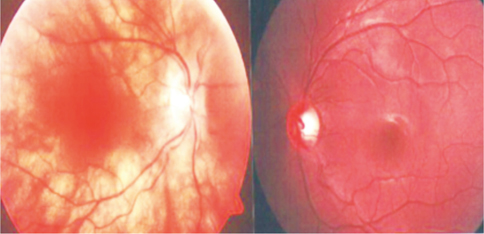Asia Pac Allergy.
2011 Jul;1(2):98-103. 10.5415/apallergy.2011.1.2.98.
Vogt-Koyanagi-Harada disease in an 8-year-old boy
- Affiliations
-
- 1Department of Child Health, Medical School, Padjadjaran University, Dr. Hasan Sadikin Hospital, Bandung, Indonesia. setiabudiawan@yahoo.com
- 2Department of Ophthalmology, Medical School, Padjadjaran University, Cicendo Eye Hospital, Bandung, Indonesia.
- KMID: 2397169
- DOI: http://doi.org/10.5415/apallergy.2011.1.2.98
Abstract
- Vogt-Koyanagi-Harada (VKH) disease is an autoimmune disease involving pigmented tissue in eyes, auditory system, skin, and central nervous system. The pathogenesis is a result of T cell lymphocyte reaction against melanocyte component, tyrosinase and tyrosinase-related protein. This disease uniquely affected pigmented race in Asia and native America, mostly women aged 20-50. We reported an 8-years-old boy complained for visual disturbance since 6 weeks prior admission. Two years earlier, the parents noted the patient eyes were looked red when photographed (suggesting a dilated pupil) preceded by whitened on the right forehead and nose and whitened hair, eyebrow and eyelashes. The examination showed a vitiligo and skin atrophy on right frontal and right nasal, poliosis on the eyebrows, eyelids and hair. The diameter of right pupil was 8 mm, with a paresis on 3rd, 4th, 6th, and 9th nerves. Fundus examination revealed sunset glow appearance. The visual acuity on the right eye: 2/60, left eye: 1-0. There's positive serology for antitoxoplasma IgG, anti Rubella IgG, anti CMV IgG. The patient was diagnosed with a VKH disease and then prescribed with methylprednisolone 1 mg/kg/day. The patient also had further follow up with dermatovenerologist and ophthalmologist. The eye examination revealed an improvement on right eye panuveitis, with a remaining keratic precipitate in the endothelium, and minimal flare and cell on the anterior chamber. ENT consultation revealed no ear inflammation or hearing disturbance.
MeSH Terms
-
Americas
Anterior Chamber
Asia
Atrophy
Autoimmune Diseases
Central Nervous System
Child*
Continental Population Groups
Endothelium
Eyebrows
Eyelashes
Eyelids
Female
Follow-Up Studies
Forehead
Hair
Hearing
Humans
Immunoglobulin G
Lymphocytes
Male*
Melanocytes
Methylprednisolone
Monophenol Monooxygenase
Nose
Otitis
Panuveitis
Parents
Paresis
Pupil
Rubella
Skin
Uveomeningoencephalitic Syndrome*
Visual Acuity
Vitiligo
Immunoglobulin G
Methylprednisolone
Monophenol Monooxygenase
Figure
Reference
-
1. de Carvalho JF, Yamamoto JH. Shoenfeld Y, Cervera R, Gershwin ME, editors. Vogt-Koyanagi-Harada disease. Diagnostic criteria in autoimmune disease. 2008. 1st ed. New Jersey: Humana Press;467–470.
Article2. Rao NA, Inomata H. Yanoff M, Duker JS, editors. Vogt-Koyanagi-Harada disease. Ophthalmology. 2009. 3rd ed. Philadelphia: Mosby;854–856.
Article3. Tsuruta D, Hamada T, Teramae H, Mito H, Ishii M. Inflammatory vitiligo in Vogt-Koyanagi-Harada disease. J Am Acad Dermatol. 2001. 44:129–131.
Article4. Sheu SJ, Kou HK, Chen JF. Significant prognostic factors for Vogt-Koyanagi-Harada disease in the early stage. Kaohsiung J Med Sci. 2004. 20:97–105.
Article5. Gocho K, Kondo I, Yamaki K. Identification of autoreactive T cells in Vogt-Koyanagi-Harada disease. Invest Ophthalmol Vis Sci. 2001. 42:2004–2009.6. Read RW. Vogt-Koyanagi-Harada disease. Ophthalmol Clin North Am. 2002. 15:333–341.
Article7. Islam SM, Numaga J, Fujino Y, Hirata R, Matsuki K, Maeda H, Masuda K. HLA class II genes in Vogt-Koyanagi-Harada disease. Invest Ophthalmol Vis Sci. 1994. 35:3890–3896.8. Akib AA. Akib AA, Munasir Z, Kurniati N, editors. Autoimunitas. Buku ajar alergi - imunologi anak. 2008. 2nd ed. Jakarta: Ikatan Dokter Anak Indonesia;160–176.9. Murphy K, Travers P, Walport M. Janeway's immunobiology. 2008. 7th ed. New York: Garland Science.10. Abbas AK, Lichtman AH. Cellular and molecular immunology. 2005. 5th ed. Philadelphia: Elsevier Saunders.11. Kouda N, Sasaki H, Harada S, Yamada Y, Takahashi N, Sasaki K. Early manifestation of Vogt-Koyanagi-Harada disease as unilateral posterior scleritis. Jpn J Ophthalmol. 2002. 46:590–593.
Article12. Usui Y, Goto H, Sakai J, Takeuchi M, Usui M, Rao NA. Presumed Vogt-Koyanagi-Harada disease with unilateral ocular involvement: report of three cases. Graefes Arch Clin Exp Ophthalmol. 2009. 247:1127–1132.
Article13. Yang P, Ren Y, Li B, Fang W, Meng Q, Kijlstra A. Clinical characteristics of Vogt-Koyanagi-Harada syndrome in Chinese patients. Ophthalmology. 2007. 114:606–614.
Article14. da Silva FT, Damico FM, Marin ML, Goldberg AC, Hirata CE, Takiuti PH, Olivalves E, Yamamoto JH. Revised diagnostic criteria for Vogt-Koyanagi-Harada disease: considerations on the different disease categories. Am J Ophthalmol. 2009. 147:339–345.15. Rao NA, Gupta A, Dustin L, Chee SP, Okada AA, Khairallah M, Bodaghi B, Lehoang P, Accorinti M, Mochizuki M, Prabriputaloong T, Read RW. Frequency of distinguishing clinical features in Vogt-Koyanagi-Harada disease. Ophthalmology. 2010. 117:591–599.
Article16. Shinzato M, Yamamoto JH, Hirata CE, Olivalves E, Bonfá E. Anti-SS-A/Ro reactivity in patients with Vogt-Koyanagi-Harada syndrome. Lupus. 2004. 13:279–280.17. Freeman AF, Holland SM. The hyper-IgE syndromes. Immunol Allergy Clin North Am. 2008. 28:277–291.
Article18. Grimbacher B, Holland SM, Gallin JI, Greenberg F, Hill SC, Malech HL, Miller JA, O'Connell AC, Puck JM. Hyper-IgE syndrome with recurrent infections. an autosomal dominant multisystem disorder. N Engl J Med. 1999. 340:692–702.19. Chee SP, Jap A, Bacsal K. Prognostic factors of Vogt-Koyanagi-Harada disease in Singapore. Am J Ophthalmol. 2009. 147:154–161.
Article20. Rubsamen PE, Gass JD. Vogt-Koyanagi-Harada syndrome. Clinical course, therapy, and long-term visual outcome. Arch Ophthalmol. 1991. 109:682–687.
- Full Text Links
- Actions
-
Cited
- CITED
-
- Close
- Share
- Similar articles
-
- Vogt-Koyanagi-Harada Syndrome Associated with Psoriasis Vulgaris
- Photodynamic Therapy with Verteporfin for Subfoveal Choroidal Neovascularization in Vogt-Koyanagi-Harada Syndrome
- A Case of Vogt-Koyanagi-Harada syndrome presenting initially with recurrent vertigo
- A Case of Vogt-Koyanagi-Harada Syndrome
- A Case of Vogt-Koyanagi-Harada's Syndrome






